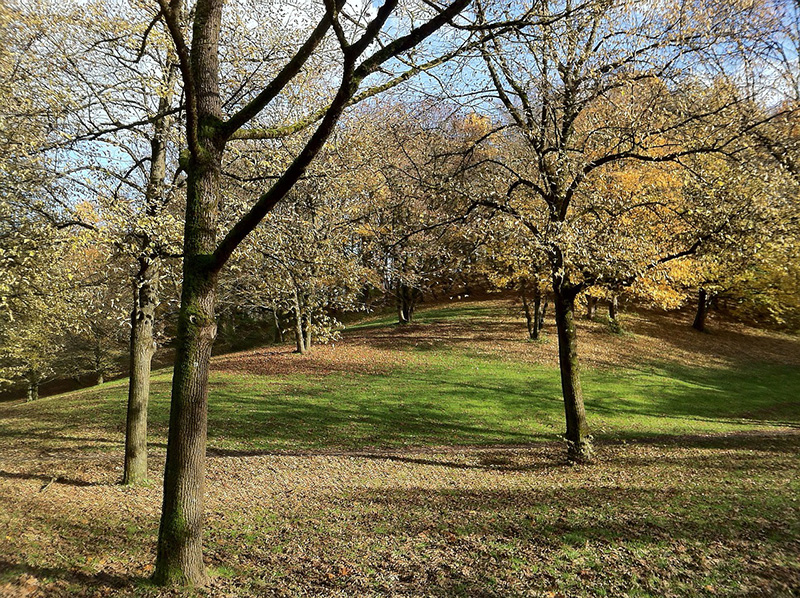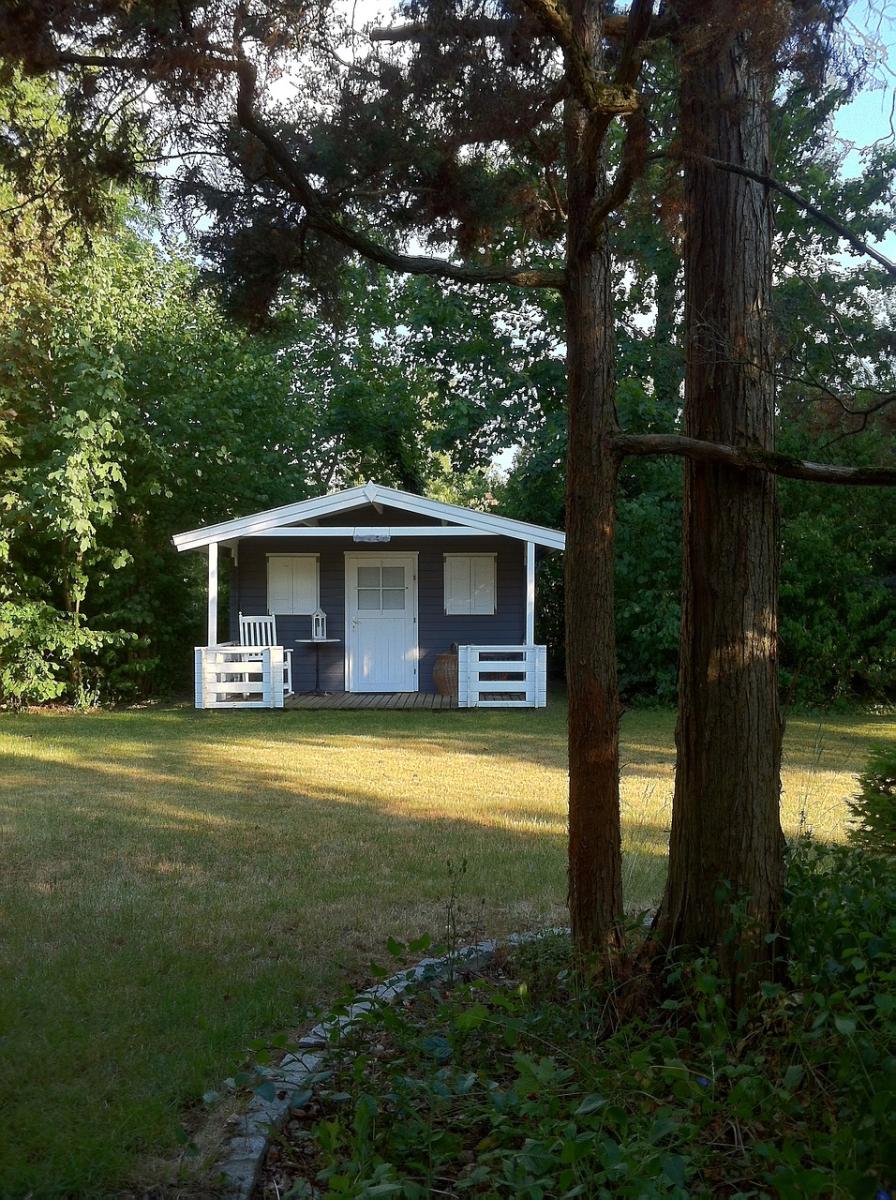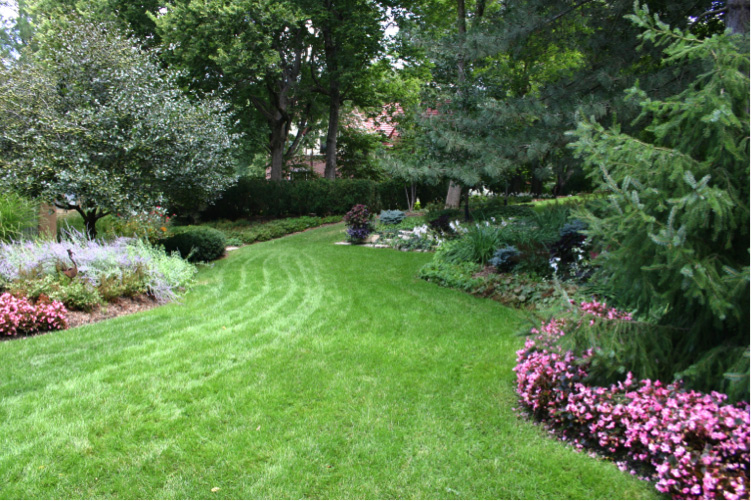
Picture-perfect lawns under the shade of mature trees - it sounds nice, but is often not realistic especially for trees which produce very dense shade like oaks and linden. Acceptable lawns in partial shade are possible, however some modifications in lawn care are needed.
 Assess Your LightTo really thrive, turfgrasses need a minimum of 6-hours full sun a day. If your shady area gets less sun, keeping grass healthy – even shade tolerant blends - will be a challenge. Examine how light moves across your property to determine how many hours of sun turf areas receive in summer when tree canopies are fully leafed.
Assess Your LightTo really thrive, turfgrasses need a minimum of 6-hours full sun a day. If your shady area gets less sun, keeping grass healthy – even shade tolerant blends - will be a challenge. Examine how light moves across your property to determine how many hours of sun turf areas receive in summer when tree canopies are fully leafed.
If possible, prune trees and large shrubs to allow more light to reach the lawn. Pruning vegetation to allow more air circulation will also help the lawn grow better. But don’t ruin the shape of trees or shrubs just to get more sunlight to a turfgrass.
In very densely shaded areas, consider switching to a shade-tolerant groundcover, combined with mulch. Here’s a resource on selecting Plants for Shade Landscapes, including groundcovers. Converting a densely shaded area from grass to a shade-loving shrub, perennial and/or annual bed will definitely reduce your lawn care headaches.
Select for Shade Tolerance
If your area gets the minimum amount of sunlight necessary for good growth, look for shade-tolerant grass blends. Fine fescues (creeping red, Chewings, hard and sheep fescue) and turf type tall fescue are the primary lawn species suggested for shade areas. Kentucky bluegrass prefers full-sun and usually suffers in shade, although there are a few shade-tolerant cultivars. Most shade lawn mixes in garden centers contain fine fescue and shade tolerant Kentucky bluegrass cultivars, so look for one that contains turf-type tall fescue, too.
Some grass seed mixes also include perennial ryegrass, which is a short-term grass in Nebraska lawns. It germinates quickly but will not survive long in shade - only one or two seasons.
Provide Good Care
Care of lawns in shady areas should be as good as for lawns located in full sun. Start by mowing high – 3 to 3.5 inches all summer – to encourage a deep root system and reduce weed problems. Many lawns are mowed too short, allowing more light to reach the soil surface and encourage weed seeds to germinate. Mow often enough so no more than one-third of the leaf blade is removed at any mowing.
 When lawns need water, even those in shade, irrigate infrequently but water deeply. What is infrequent? After two to three weeks with no rain, if wilt symptoms are appearing in the lawn, water very deeply once. How deep is deep? The goal is to moisten soil to the bottom of turf roots – typically 6 inches. Wait to water again until the top 2-3 inches of soil appear dry, which may be one, two or more weeks depending on temperatures. Overwatering, especially in shaded areas, results in poor root development which contributes to a lowering of plant vigor.
When lawns need water, even those in shade, irrigate infrequently but water deeply. What is infrequent? After two to three weeks with no rain, if wilt symptoms are appearing in the lawn, water very deeply once. How deep is deep? The goal is to moisten soil to the bottom of turf roots – typically 6 inches. Wait to water again until the top 2-3 inches of soil appear dry, which may be one, two or more weeks depending on temperatures. Overwatering, especially in shaded areas, results in poor root development which contributes to a lowering of plant vigor.
Reduce traffic over lawns in the shade as much as possible to minimize wear and prevent soil compaction.
Annual core aeration is an excellent practice to consider, especially for lawns growing on disturbed soil, like those around new construction homes or in areas of heavy clay soils. Spring and fall are good times to aerate.
Two common problems in shade lawns are moss or shade-loving weeds like ground ivy. These problems exist primarily because shade lawns tend to be thin, weak and overly moist at some points during the growing season, allowing easy invasion. Follow the steps outlined above to maintain plant vigor and overseed as needed to maintain density.
I Need a Miracle Grass!
You may read an advertisement that says, "This grass will provide a great-looking lawn with little mowing, watering, or fertilizer in the sun or shade, regardless of how many kids play on it." This sounds like good news, right? Ads say such grasses exist, yet the traditional grass species used in our area, such as Kentucky bluegrass, tall fescue, or perennial ryegrass don't fit these claims. Do "miracle" grasses live up to their hype and are they worth the money?
When considering purchase of any plant material, it is essential to know exactly what species of grass you are buying. When dealing with turfgrasses, the cultivars (cultivated varieties) in the seed or sod are also important. Often, these “miracle grass” advertisements don’t list the actual species and cultivars – so what are you really getting? Don’t spend your money if grass species are not listed. Oftentimes inferior turfgrass species may be in the product, such as annual ryegrass.
Fine fescues (creeping red, Chewings, hard and sheep fescue) are a common component of shade blends, but don’t perform well in the full sun areas in Nebraska landscapes. They should also not be used alone - meaning don't seed your entire lawn to red fescue. Instead, they should be blended with shade tolerant tall fescue and Kentucky bluegrass cultivars.
Neither zoysiagrass or buffalograss will grow at all in shade, so they are not good alternatives for a shady area.
Bottomline - If the ad makes a lawn grass sound too good to be true, it probably is.
Images
- Feature image - Turfgrasses require a minimum of 6 hours full sun to be healthy and vigorous. Too much shade reduces grass vigor and causes turf thinning. Image from Pixabay.com.
- If pruning is possible without ruining a tree's shape, limbing up branches allowing more light to reach the grass beneath will help improve grass performance. Image from Pixabay.com.
- Converting heavily shaded areas out of turfgrass and replacing it with shade loving shrubs and perennials is a great long-term option to reduce your lawn management headaches. Image by John Fech, Nebraska Extension.